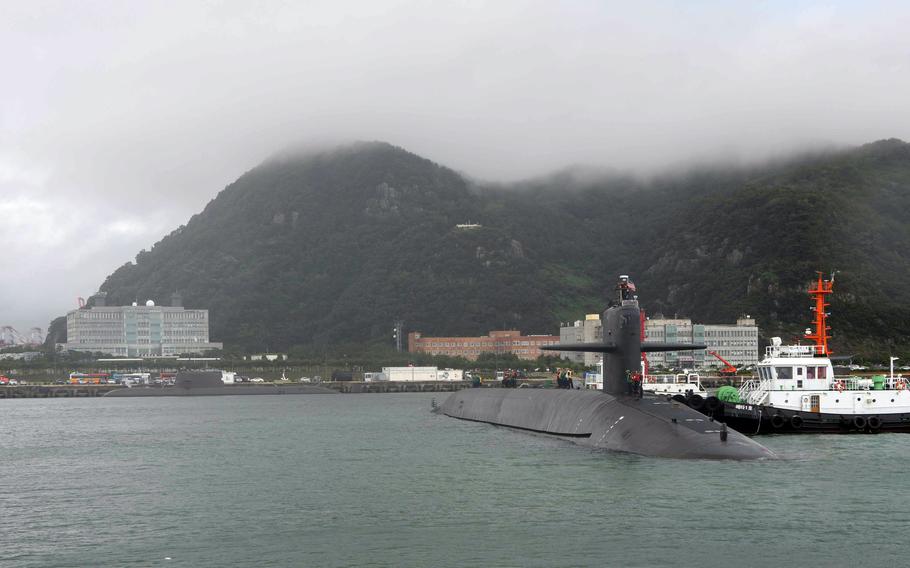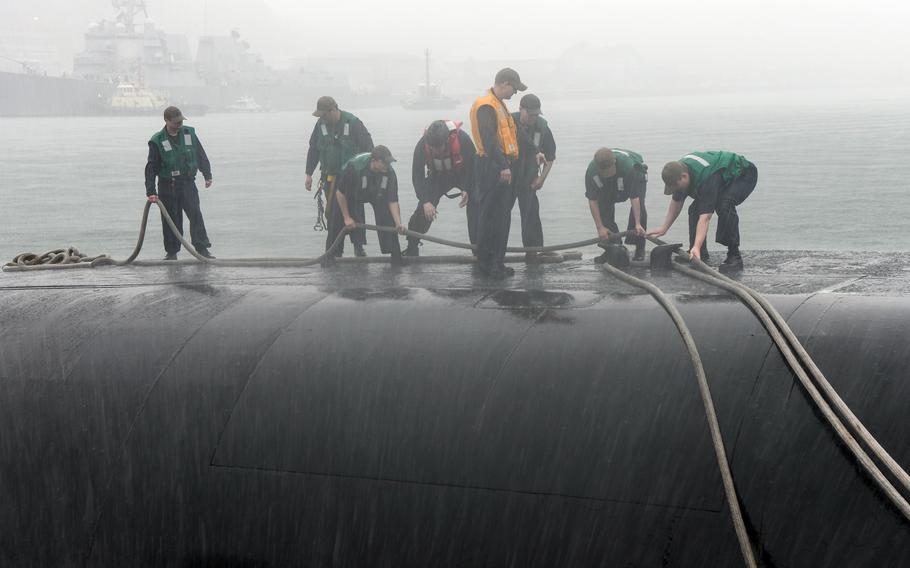
The Ohio-class ballistic missile submarine USS Kentucky pulls into Busan, South Korea, Tuesday, July 18, 2023. (Michael Chen/U.S. Navy)
CAMP HUMPHREYS, South Korea — The presence of a nuclear-capable U.S. ballistic missile submarine in South Korea could meet the conditions set by North Korea for a preemptive nuclear strike, according to the regime’s defense minister.
The USS Kentucky’s arrival Tuesday in Busan could trigger Pyongyang’s preemptive nuclear strike policy, Defense Minister Kang Sun-nam said in the state-run Korean Central News Agency on Thursday.
“I remind the U.S. military of the fact that the ever-increasing visibility of the deployment of the strategic nuclear submarine and other strategic assets may fall under the conditions of the use of nuclear weapons specified in [North Korea’s] law …,” Kang said in an article posted online by KCNA. “[North Korea’s] doctrine on the use of nuclear weapons allows the execution of necessary action procedures in case a nuclear attack is launched against it, or it is judged that the use of nuclear weapons against it is imminent.”
The Kentucky’s port call is part of an agreement between President Joe Biden and South Korean President Yoon Suk Yeol to increase the “visibility of strategic assets on the Korean Peninsula” in light of North Korean threats, according to a statement from the two leaders in April.
North Korea has “misrepresented” the purpose of the Kentucky’s visit, the South’s Ministry of National Defense in a news release Friday.
Seoul and Washington’s decision to deploy the submarine is a “legitimate defensive response” and “is not a plot to use nuclear weapons or a nuclear threat against North Korea,” according to the ministry.
Yoon went aboard the Kentucky on Wednesday and in a speech said a nuclear attack by North Korea “would lead to the end of the regime.”
The submarine is one of 14 Ohio-class submarines in the Navy’s fleet and can carry 20 nuclear-tipped ballistic missiles that have a range of 4,000 miles.

Sailors heave a line to bring the Ohio-class ballistic missile submarine USS Kentucky into port in Busan, South Korea, Tuesday, July 18, 2023. (Michael Chen/U.S. Navy)
North Korea has fired 17 ballistic missiles in 12 separate days of testing so far this year. The communist regime last fired a Hwasong-18 intercontinental ballistic missile on Wednesday.
North Korea’s Supreme People’s Assembly codified an “irreversible” nuclear weapons program and a preemptive-use policy in September. The law broadly states that the regime may conduct a preemptive nuclear strike if its leaders or nuclear operations were threatened by hostile forces.
U.S. and South Korean intelligence agencies have said over the past year that Pyongyang is prepared to carry out its seventh nuclear test.
The explosion from North Korea’s last nuclear device in 2017 was estimated to be equivalent to 250 kilotons of TNT, or roughly 16 times that of the atomic bomb dropped on Hiroshima in 1945, according to a study published in the Journal of Geophysical Research: Solid Earth.
In addition to the nuclear tests, North Korea is believed to have “reached a significant level in the miniaturization of nuclear weapons” and have a stockpile of around 150 pounds of plutonium, South Korea said in its annual military report in February.